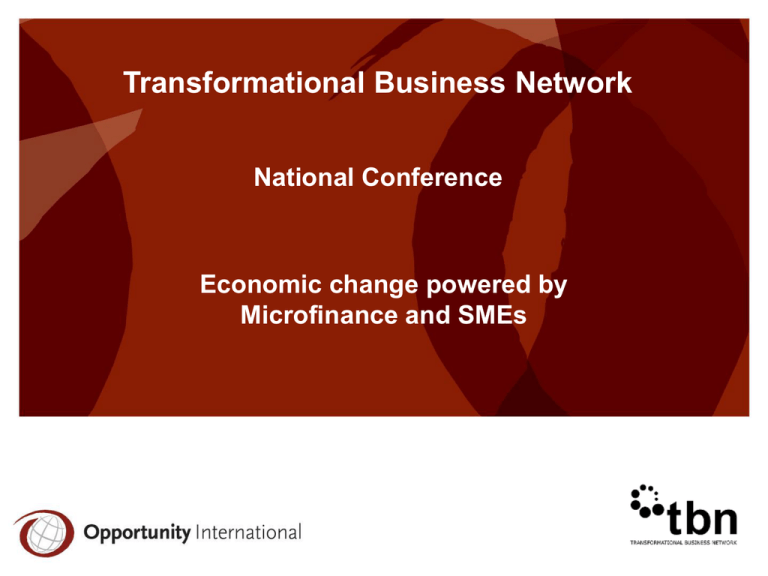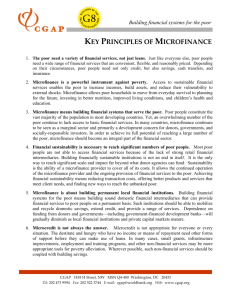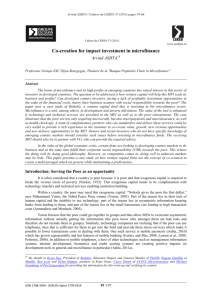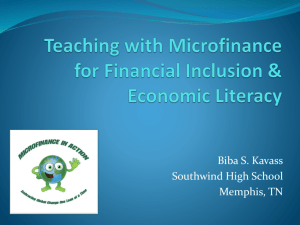1 Terry Winters - Transformational Business Network
advertisement

Transformational Business Network National Conference Economic change powered by Microfinance and SMEs Poverty – the facts Approximately 790 million people in the developing world are still chronically undernourished, almost two-thirds of whom reside in Asia and the Pacific 2.6 billion people around the world do not have access to toilets or basic sanitation, causing fatal illnesses that could easily be prevented 1.1 billion people do not have access to clean drinking water. Instead, they are forced to drink, cook with and wash in contaminated water sources every day Every 3.6 seconds, someone in the world dies from starvation. The majority are children under five years old Poverty – the facts cont’d 90% of starvation deaths happen where food is plentiful, but people simply cannot afford to buy it. War, disaster and famine account for only 10% of all starvation deaths Nearly a billion people entered the 21st century unable to read a book or sign their names 800 million people go to bed hungry every night, 300 million are children 1.6 billion people – a quarter of humanity – live without electricity A London parking meter makes more money in one hour than each of the 2.7 billion people living in poverty make in one day. What Opportunity International Does Opportunity International exists to give people living in poverty opportunities to transform their lives. This is done through small loans (microfinance) that help them start a business, earn an income and provide for their families. Where Opportunity works 28 Countries 40 Implementing Partners (incl. 15 regulated banking institutions) Opportunity Vital Statistics As at March 31, 2010 ~3 million clients (incl. > .6 million savings clients) • > 1 million in India • > •75 million in Philippines • > •75 million in Sub-Saharan Africa > 3.0 million micro insurance clients 84% of loans made to women US$285 average loan size US$138 average initial group loan US$122 average savings balance Income Distribution Pyramid Individual Lending/SME Solidarity Groups (3-7) Trust Groups (15-25) Self-Help Groups (20-30) Microfinance moving people up the poverty pyramid Positioning of market participants Profit Maximizers Percentage of World Poor Average First Loan Size Commercial Banks NGOs Transformation Maximizers Economic Social Transformational Impact Spiritual Transformational Microfinance Holistic transformation Microfinance / SME Initiatives Community Centre And Safe Drinking Water Supply Waterhope Harnesses Entrepreneurs For Sustainable Community Building The Waterhope Project…. Leverages a strong network of OI NGO’s in Philippines Is integrated with existing OI micro finance network Each station provides clean water to over 12,000 people every week Requires US$96,000 start-up investment per station Waterhope builds sustainable local entrepreneurship…. Reinvests in local community building Supports new water businesses for local community members Is an ideal focus for local PepsiCo employee CSR efforts Has a sustainable, scalable and proven business model Each Water Station Provides Clean Water to over 12,000 People Weekly Livelihood impacts for community • 4 direct employees • 60 dealers to date with water businesses • Access to micro finance loan funds benefiting approximately 250 households • 1,500 individuals community development services water source Community Water Station 5,400 water jugs (5 gallons) per week • 90% of water sold to Dealers; 4,860 jugs/week • Average Dealer Route is 25 homes, 2 jugs/week • Supply 4,860 households = 12,150 people/week • 10% water given free to schools and clinics (540 jugs per week) Excellent Water Quality Meets All Government Purity Standards Pure water rinsed Municipal water or spring water Pilots use carbon filter with UV treatment Water quality government tested monthly Risk of water contamination limited by jug design and heat seal Pilot equipment supplier: Waterhealth and Aqua Add on Heat sealed for safety The Water Station Becomes A Community Focal Point Community gathering place Microfinance Centre Pre-School and library Community Services “Give a man a fish, he’ll eat for a day. Give a woman microcredit, she, her husband, her children and her extended family will eat for a lifetime” – Bono, U2 Rubbish dump in Manila Agriculture Microfinance- SME Agriculture initiatives in Africa 3/4 of population live in rural areas Agriculture is key sector in economies, but low productivity Food shortages and insecurity remain high Smallholder has impaired access to technical assistance and credit Our Response Strong commitment to the sector An integrated rural finance and banking strategy: Agricultural finance Rural savings Banking Infrastructure Ancillary credit programs (e.g., health, education, etc.) A prudent approach – achieve sustainability Development Agriculture’s impact on development is profound: labour goods (food, inputs) market for manufactures financial resources; and foreign exchange Binding constraint on industry; output growth crucially dependent on agriculture Relative importance of sector declines in the course of economic development Interconnected Web of Essential Relationships Output Market • Contract • Auction • Trader Microfinance • Savings • Loans • Insurance Market Information Systems FARMER Inputs Infrastructure • Seed • Tools • Fertilizer • Chemicals • Communications • Power • Roads • Water Support • Extension Services • Technical Support • R&D CGAP’s View CGAP conducted thorough review of agriculture microfinance programs in 2002. Out of 80 ‘promising’ projects, less than 30 were considered to have potential for sustainability. NONE were considered to be an unqualified ‘success.’ The difficulty in finding a large number of examples of successful providers of agricultural microfinance shows how susceptible the field is to factors beyond its control—and how necessary it is for agricultural lenders to adopt the most important lessons of the microfinance industry to minimize controllable lending risks. It also serves as a cautionary tale for microlenders moving into rural areas and lending to households that depend on agriculture for their livelihoods. - CGAP 2002 Education Microfinance - SME School building in Malawi funded by Opportunity Supported an additional 100 students paying nominal fees of $15 each per Semester Headmaster Explaining Model & Success Students achieving results in top 10% for grade in country after two years School children during break Microfinance WORKS – but... Microfinance improves health, increases school enrolment, and helps the poor work their way out of poverty It is highly effective in countries with high rates of poverty and stable political and economic environments The industry is currently serving over 133 million borrowers, Microfinance is rapidly increasing to meet massive demand Recent recognitions of the power of microfinance: 2005: UN declares “Year of Microcredit” 2006: Muhammad Yunus, Grameen Bank awarded Nobel Peace Prize Sources: Microcredit Summit Campaign 2007, the Microfinance Gateway, Deutsche Bank Moving beyond loans » Many of the problems facing the poor can be solved with small loans, but some cannot » Poor need a wide range of services to address their various financial needs » Savings Income generation – A safe place to keep money, income protection » Insurance – Protection in times of crisis: death, drought, disability » Money transfers – Sending and receiving money to/from other family members Income protection “You must be the change you wish to see in the world” - Mahatma Gandhi But for the Grace of God – I could have been born here!!






